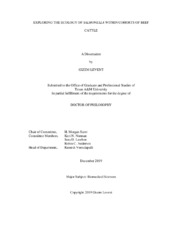| dc.description.abstract | Salmonella is a leading bacterial pathogen, causing a significant number of human infections and deaths every year in the United States. Recently, the increase in the prevalence of ceftriaxone and azithromycin resistance among human Salmonella isolates became a serious public health threat since both are used for the empirical treatment of salmonellosis. Analogs of these antibiotics (ceftiofur and tulathromycin, respectively) are widely used in beef cattle, which could be contributing to this problem, since beef products are one of several major sources of Salmonella outbreaks.
A randomized controlled longitudinal field trial was designed to determine the effects of single-doses of ceftiofur and tulathromycin metaphylactic treatment on Salmonella prevalence, quantity and serotype distribution among cattle feces, sub-iliac lymph nodes, and hide samples. Beef cattle (n = 134) were divided 4 blocks consisting of three pens each. One pen in each block received either ceftiofur, tulathromycin, or else no antibiotic (i.e., negative control group) on Day 0. Feces (during the feeding period and at slaughter), sub-iliac lymph nodes and hide swabs (at slaughter) were collected from each animal, during periods before and after the treatment. Salmonella was isolated, quantified and tested for phenotypic antibiotic resistance using standard methods. Serotypes, sequence types, antibiotic resistance genes, and plasmids of Salmonella isolates were determined from whole-genome sequencing data. Phylogenetic analyses were performed to measure evolutionary distances between Salmonella comparing pens, source, days, sample types across the study period. Data analyses indicated no significant effects (P > 0.05) of metaphylactic antibiotic treatments on the prevalence and quantity of Salmonella; however, there was a significant (P < 0.05) day (period) effect observed in both measures of Salmonella occurrence, increasing significantly from early spring through mid-summer. Salmonella isolates were mostly pan-susceptible and this was not affected by the antibiotic treatment. Serotypes found in cattle samples strongly clustered within pens and dynamically shifted their dominance over time; importantly, suggesting a strong interaction of this pathogen with the local ambient cattle pen environment. Further analyses are needed to understand the environmentally related dynamics of Salmonella originating from cattle. | en |


